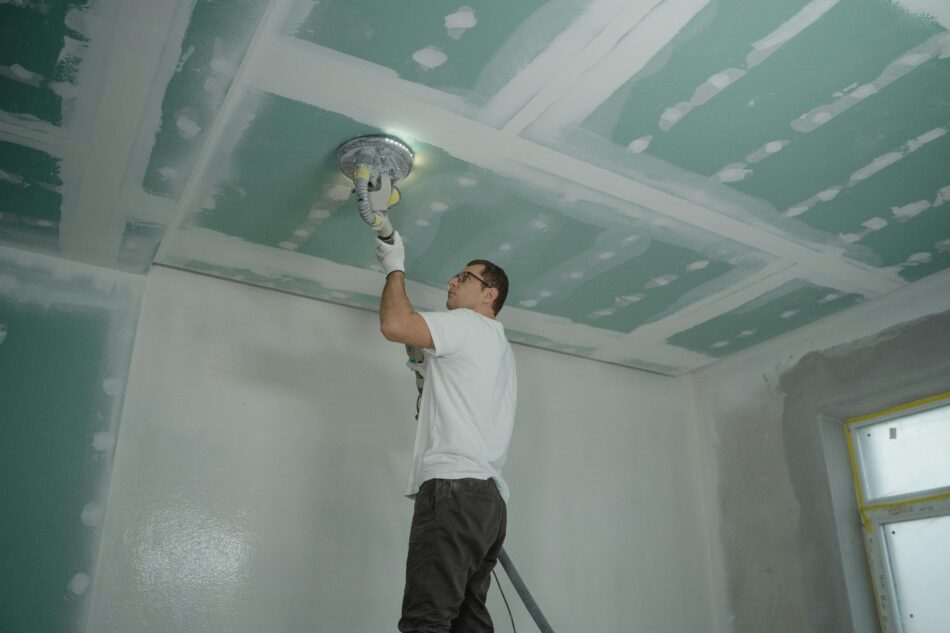Your ceiling often goes unnoticed until something goes wrong. One day it’s perfectly fine, and the next, you notice cracks, stains, or even sagging. That’s where ceiling repair contractors come in—they have the skills and tools to identify hidden damage and fix it before it becomes a costly disaster. Whether it’s water damage, structural issues, or aging materials, professionals ensure your ceiling remains safe, durable, and aesthetically pleasing.
Common Causes of Hidden Ceiling Damage
Water Leaks and Moisture Problems
Water is a silent enemy of ceilings. Leaks from roofs, plumbing, or even condensation can seep into your ceiling unnoticed. Over time, this moisture weakens the material, causing sagging, mold growth, and even structural damage.
Structural Weakness or Aging Materials
Old homes may have ceilings made of materials that naturally degrade over time. Wooden beams can warp, plaster can crack, and drywall can sag. These issues often hide behind paint or finishes, making early detection difficult.
Pest Infestation and Mold Growth
Termites, rodents, and mold can hide in your ceiling, causing invisible damage. Mold spores thrive in damp areas, while pests can chew through wood and drywall, weakening your ceiling’s structure.
Signs That Your Ceiling May Have Hidden Damage
Sagging or Bowing Areas
Notice uneven surfaces or bulging sections? These are classic signs that your ceiling has hidden structural issues or trapped moisture.
Discoloration and Stains
Yellow or brown stains often indicate water leaks. If left unchecked, these spots can grow and damage surrounding areas.
Cracks and Flaking Paint
Small cracks may look harmless but can expand over time. Flaking or peeling paint is another sign that something is brewing beneath the surface.
Tools and Techniques Experts Use to Detect Damage
Visual Inspection
Professionals start with a thorough visual check. Every crack, stain, or sagging area is closely examined.
Moisture Meters and Infrared Cameras
Advanced tools like moisture meters and infrared cameras help detect hidden leaks and damp spots without tearing your ceiling apart.
Tapping and Sound Testing
A simple tap can reveal hollow or weakened areas. Unusual sounds often point to structural issues needing attention.
The Role of Professional Ceiling Repair Contractors
Why DIY Repairs Can Be Risky
Attempting repairs without proper knowledge can worsen the problem. Water damage, for instance, can hide behind drywall, and improper patching may lead to mold growth.
How Professionals Diagnose Hidden Issues
Ceiling repair contractors have the expertise to uncover underlying problems. They use specialized tools, know common problem areas, and ensure repairs address the root cause, not just the symptoms.
Step-by-Step Process of Repairing Ceiling Damage
Removing Damaged Material
The first step is removing weakened plaster, drywall, or wood. This ensures that repairs are effective and long-lasting.
Drying and Treating the Area
Moisture must be completely dried, and mold or pests treated before repairs.
Patching and Reinforcing
Next, damaged areas are patched using suitable materials. Reinforcements may be added to ensure stability.
Painting and Finishing Touches
Finally, the ceiling is painted and finished, restoring its original look and protecting it from future damage.
Drywall Ceiling Repair: What You Should Know
If your ceiling has drywall, knowing when to call for “drywall ceiling repair near me” is crucial. Common issues include cracks, water stains, and sagging panels. Professionals ensure that drywall is patched seamlessly and reinforced properly, so it blends perfectly with the rest of your ceiling.
Preventive Measures to Avoid Hidden Ceiling Damage
Regular Inspections
Check your ceiling periodically for minor issues before they turn into major repairs.
Controlling Moisture Levels
Keep humidity in check and fix leaks promptly to avoid water damage.
Proper Ventilation and Insulation
Adequate airflow and insulation prevent condensation and mold growth, protecting your ceiling in the long run.
Choosing the Right Ceiling Repair Contractor
Checking Credentials and Reviews
Always hire licensed professionals with positive reviews. Their experience ensures quality repairs.
Comparing Quotes and Services
Get multiple estimates and ask about the repair process, materials used, and warranties offered.
Cost Factors in Ceiling Repair
Repair costs vary depending on the material, extent of damage, and labor. Minor patching may cost less, but extensive water damage or structural issues can require a full ceiling replacement.
Conclusion
Hidden ceiling damage can lead to costly repairs if ignored. By recognizing the signs, consulting professional ceiling repair contractors, and performing timely maintenance, you protect both your home and your peace of mind. Remember, early detection and expert repair save you money and stress in the long run.
FAQs
1. How do I know if my ceiling has hidden damage?
Look for sagging, discoloration, cracks, or flaking paint, and consult a professional for a thorough inspection.
2. Can I repair ceiling damage myself?
Minor cosmetic fixes are possible, but hidden damage requires expert evaluation to avoid worsening the problem.
3. How long does ceiling repair take?
Repairs may take a few hours for minor issues or several days for extensive water or structural damage.
4. What is the average cost of ceiling repair?
Costs depend on the damage type, materials, and labor; minor repairs are cheaper than full replacements.
5. How can I prevent future ceiling problems?
Regular inspections, moisture control, proper ventilation, and timely repairs keep your ceiling in great condition.







